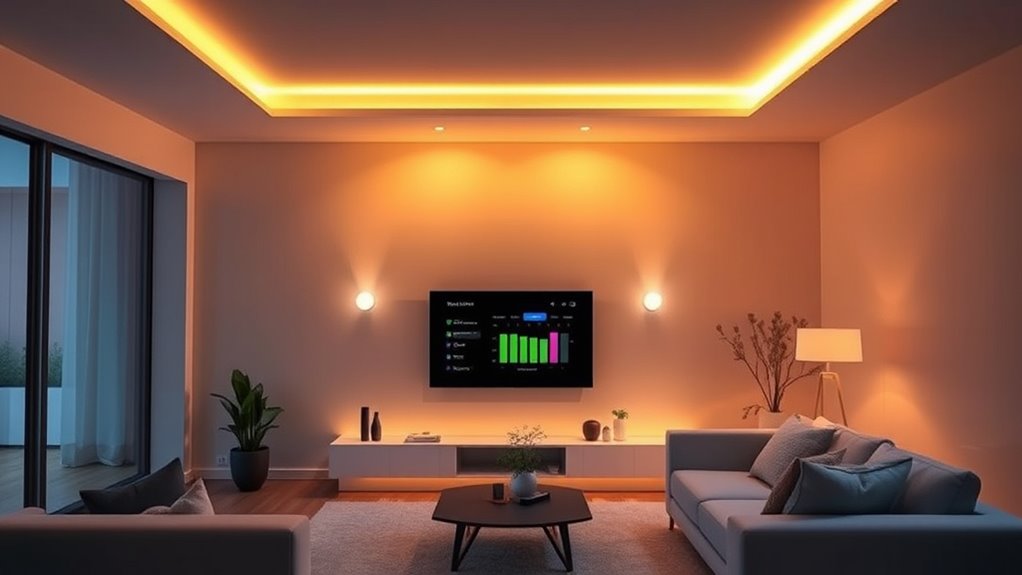To automate your home lighting with circadian rhythm scripts, you’ll need smart lighting systems, sensors, and a compatible hub. First, set schedules that mimic natural light patterns, like warming tones in the morning and dimming in the evening. Adjust brightness and color temperature based on time and sensor data for a healthier sleep-wake cycle. If you continue, you’ll discover detailed steps to create, customize, and maintain effective lighting scripts.
Key Takeaways
- Use smart lighting systems with scheduling and dimming features to align lighting with natural circadian patterns.
- Incorporate sensors like ambient light and motion detectors to enable real-time, adaptive lighting adjustments.
- Create scripts that mimic natural light changes—gradual dawn and dusk, warmer evening tones, and seasonal shifts.
- Customize lighting brightness and color temperature based on wake and sleep times to promote healthy circadian rhythms.
- Regularly test and refine scripts, ensuring compatibility with your smart home ecosystem for seamless automation.
Understanding Circadian Rhythms and Light’s Role in Sleep

Understanding circadian rhythms is essential because they regulate your sleep-wake cycle, aligning your body’s functions with the natural light-dark pattern. Your internal clock responds to light exposure, signaling when to feel alert or sleepy. In the morning, sunlight triggers a boost in hormones like cortisol, helping you wake up and feel energized. As evening approaches and light diminishes, your body increases melatonin production, preparing you for sleep. Disruptions to this cycle—like artificial lighting at night or irregular schedules—can throw off your sleep quality and overall health. By understanding how light influences your circadian rhythm, you can better appreciate the importance of proper lighting at different times of day. This awareness is key to optimizing sleep and maintaining a healthy biological clock. Additionally, research on light’s impact on brainwave patterns indicates that specific lighting adjustments can further support your sleep health.
Benefits of Automating Your Home Lighting Based on Your Biological Clock

Automating your home lighting to align with your biological clock offers numerous benefits, making it easier to maintain healthy sleep patterns and boost overall well-being. By syncing your lights with natural circadian rhythms, you’ll experience improved sleep quality and feel more energized during the day. This automation helps regulate hormone production, like melatonin and cortisol, which influence sleep and alertness. It also reduces disruptions caused by artificial lighting at inappropriate times, minimizing sleep disturbances. Additionally, aligning lighting with your biological clock can enhance mood, productivity, and focus. Incorporating light spectrum adjustments can further optimize your environment for better health. Over time, these benefits support better mental and physical health, helping you feel more balanced and refreshed. Overall, automating your lighting based on your internal clock creates a more natural, healthier environment for daily living.
Essential Tools and Devices for Circadian Lighting Automation

To effectively set up circadian lighting automation, you’ll need a combination of essential tools and devices that work together seamlessly. First, a smart lighting system compatible with automation scripts is vital; look for bulbs or fixtures that support scheduling and dimming. You’ll also need a hub or smart home controller, such as a smart speaker or dedicated hub, to coordinate commands. A reliable Wi-Fi network ensures smooth communication between devices. Additionally, sensors like motion detectors or ambient light sensors help adjust lighting based on real-time conditions. Finally, a smartphone or tablet with a compatible app allows you to customize schedules easily. These tools form the foundation for an effective circadian lighting setup, enabling you to automate your lighting to support your biological rhythm effortlessly.
Setting Up Your Smart Home System for Lighting Scripts

To set up your smart home system for lighting scripts, you need to make sure your devices are compatible and can communicate seamlessly. You’ll also want to explore customization options to tailor the scripts to your preferences. Finally, consider how your new setup will integrate with your existing smart home systems for smooth operation. Paying attention to AI security measures can help ensure your system remains safe from vulnerabilities.
Compatible Devices Required
Before you can set up lighting scripts, it’s vital to verify your smart home system includes compatible devices. Not all smart bulbs or switches work seamlessly with circadian rhythm scripts. You’ll need devices that support automation platforms like Zigbee, Z-Wave, or Wi-Fi with compatible apps. Check each device’s specifications to guarantee they accept scripting commands and can adjust brightness or color temperature dynamically. Additionally, considering Kia Tuning options can inspire smart vehicle integrations that enhance your overall smart home ecosystem.
Script Customization Options
Have you explored the customization options available for your lighting scripts? Adjusting these settings helps tailor your lighting experience to match your routines. Here’s what you can typically customize:
- Brightness levels – Set different intensities for morning, afternoon, and evening.
- Color temperature – Shift between warm and cool tones based on time or activity.
- Trigger points – Decide when scripts activate, like sunrise or specific times.
- Duration and progression – Control how long lighting changes last and how smoothly they shift.
- Support hours – Be aware of support hours for troubleshooting or assistance with your smart home system.
These options give you control over your environment, ensuring your lighting feels natural and supports your daily rhythm. Experiment with settings to find what feels most comfortable and energizing for you.
Integration With Existing Systems
Integrating your lighting scripts with existing smart home systems guarantees seamless operation and centralized control. Begin by ensuring your current system supports custom scripting or automation platforms like SmartThings, Home Assistant, or Hubitat. Next, connect your circadian rhythm scripts to these platforms, leveraging their automation rules or custom app integrations. This step might involve importing or copying scripts into the system’s interface and setting the appropriate triggers, such as time of day or occupancy sensors. Test the setup to confirm that lighting adjusts smoothly throughout the day. By integrating your scripts properly, you avoid conflicts with existing automations and streamline your home’s lighting adjustments, making your circadian rhythm lighting truly effortless and reliable. Additionally, understanding Gold IRA Rollovers can provide insights into diversification strategies that could be applied to your overall home automation investment planning.
Creating Scripts to Mimic Natural Light Patterns Throughout the Day

To create realistic lighting patterns throughout the day, you need to develop scripts that adjust your home’s lights in sync with natural sunlight changes. First, determine the key times of sunrise, midday, and sunset. Next, set your lights to gradually brighten in the morning, mimicking dawn. Then, dim them during late afternoon to resemble sunset. Finally, adjust lighting to cooler tones in the evening and warmer tones at dawn and dusk. To make this happen, you should:
- Use time-based triggers aligned with sunrise and sunset.
- Employ smooth dimming functions to avoid abrupt changes.
- Incorporate color temperature adjustments for different times.
- Test and refine your scripts to match seasonal shifts.
- Understanding lighting schedules and how they influence circadian rhythms can help in creating more natural lighting environments.
Customizing Lighting Schedules for Different Sleep and Wake Times

Once you’ve set up natural light patterns to mimic the sun’s cycle, customizing your lighting schedule to match your personal sleep and wake times can make a significant difference in your daily comfort and health. You can adjust your scripts to gradually shift lighting intensity and color temperature based on when you wake up and go to bed. This ensures your environment supports your unique schedule, reducing sleep disruptions. For example, if you wake earlier, your lights can brighten sooner, mimicking sunrise. Conversely, if you sleep later, your lighting can stay dimmer longer. Use the table below to plan your schedule: proper lighting adjustment methods
| Sleep Time | Wake Time |
|---|---|
| 10:00 PM | 6:00 AM |
| 11:00 PM | 7:00 AM |
| 12:00 AM | 8:00 AM |
Integrating Sensors and Data for Adaptive Light Adjustments

By integrating sensors and data, your lighting system can respond automatically to your environment. Adaptive lighting algorithms analyze this data to adjust brightness and color temperature in real time. This creates a more comfortable and energy-efficient home that adapts to your needs effortlessly. Regular updates to lighting algorithms ensure optimal performance and responsiveness.
Sensor Data Integration
Have you ever wondered how smart lighting systems automatically adjust to your environment? It all comes down to sensor data integration. When you connect sensors, you enable your system to gather real-time information about your space. Here’s how it works:
- Sensors detect ambient light levels, helping your system brighten or dim lights as needed.
- Motion sensors identify activity, ensuring lights turn off when you leave a room.
- Temperature sensors provide environmental data for comfort adjustments.
- Data from these sensors feeds into your control system, allowing seamless, automatic adjustments.
- Proper storage and maintenance of sensors are essential for accurate readings and system longevity, similar to how storage in a cool, dark place can prolong the shelf life of consumables.
Adaptive Lighting Algorithms
Ever wonder how your smart lighting system seamlessly adjusts brightness and color temperature to suit your environment? Adaptive lighting algorithms analyze sensor data like ambient light, time of day, and occupancy to make real-time adjustments. These algorithms prioritize comfort and energy efficiency, ensuring your lights respond intuitively. They can dim lights during cloudy days or brighten them when you enter a room. Here’s how different factors influence adjustments:
| Sensor Input | Adjustment Example | Result |
|---|---|---|
| Ambient Light | Increase brightness at sunset | Maintains ideal visibility |
| Occupancy | Turn off lights when empty | Saves energy |
| Time of Day | Shift to warmer tones in evening | Enhances relaxation |
Troubleshooting Common Issues in Circadian Lighting Automation

When circadian lighting automation isn’t working as expected, troubleshooting begins with checking the system’s sensors and connections. First, verify that your sensors are clean and properly positioned to detect natural light and occupancy. Next, ensure all wiring is secure and there are no loose connections. Third, confirm that your automation rules are correctly set up and haven’t been accidentally altered. Finally, check the power supply to your devices to prevent interruptions. If issues persist, test each sensor individually to identify faults, reset your system if needed, and consult device logs for error messages. Addressing these common points helps restore your lighting’s natural rhythm and keeps your automation running smoothly.
Tips for Maintaining and Refining Your Lighting Scripts Over Time

To keep your lighting system running smoothly, make sure you regularly update your scripts to accommodate changes in your routine or preferences. Keep an eye on how your lights perform, so you can catch issues early and fine-tune the automation. Consistent monitoring helps warrant your lighting remains efficient and tailored to your needs.
Regular Script Updates
Regularly updating your lighting scripts guarantees your automation stays effective and adapts to changing needs. To keep things running smoothly, consider these tips:
- Review your scripts monthly to catch any outdated routines or errors.
- Adjust timing based on seasonal shifts or changes in your routine.
- Incorporate new devices or features as you expand your smart home system.
- Test your scripts after updates to ensure they function correctly and meet your preferences.
Staying proactive ensures your lighting continues to support your circadian rhythm and enhances your daily comfort. Regular updates prevent automation from becoming stale or inefficient, keeping your home environment optimized effortlessly.
Monitor Lighting Performance
Keeping an eye on how your lighting scripts perform over time helps guarantee your automation remains reliable and effective. Regularly review your system’s behavior to spot any inconsistencies or issues early. Pay attention to whether the lights adjust as expected throughout different times of the day and seasons. Use logs or notifications to track any failures or delays, and note patterns that might indicate a need for adjustment. Test your scripts periodically, especially after updates to your smart home system or changes in your schedule. Fine-tuning your scripts based on real-world performance ensures they stay aligned with your circadian rhythm goals. Consistent monitoring helps you maintain ideal lighting, enhancing both comfort and energy efficiency in your home.
Future Trends in Circadian-Informed Home Automation

As technology advances, circadian-informed home automation is poised to transform how your lighting adapts to your natural rhythms. Expect smarter systems that learn your habits and adjust lighting automatically. Here are some exciting trends to watch:
Circadian-aware home automation will revolutionize lighting, learning habits and adapting seamlessly for healthier, smarter living.
- AI-Powered Personalization: Your home will analyze your daily patterns and optimize lighting schedules without manual input.
- Integration with Wearables: Devices like smartwatches will sync with your lighting system, fine-tuning brightness and color based on your sleep and activity data.
- Dynamic Lighting Zones: Rooms will feature adjustable lighting zones that shift throughout the day, mimicking natural sunlight.
- Voice and Gesture Control: Hands-free adjustments will become seamless, allowing you to tweak lighting based on your mood or needs instantly.
These innovations will make your home healthier, more comfortable, and energy-efficient.
Frequently Asked Questions
Can I Integrate Circadian Lighting Scripts With Existing Smart Home Platforms?
You can definitely integrate circadian lighting scripts with your existing smart home platforms. Many smart home systems support custom scripts or routines, making it easy to add circadian lighting adjustments. Check your platform’s compatibility and available automation features. Usually, you’ll need to create or upload scripts that adjust lighting based on time of day or natural light levels, helping you maintain a healthy, natural sleep-wake cycle effortlessly.
How Do I Choose the Right Light Bulbs for Circadian Automation?
When choosing the right light bulbs for circadian automation, you should look for ones that support tunable white or full-spectrum lighting. Opt for bulbs with adjustable color temperatures, ideally ranging from warm (around 2700K) to cool (up to 6500K), to mimic natural sunlight. Make sure they’re compatible with your smart home system, easy to control via apps, and energy-efficient, so you can effortlessly align your lighting with your daily rhythm.
Are There Privacy Concerns With Sensors Used in Adaptive Lighting Systems?
You might think adaptive lighting sensors are the ultimate privacy villains, spying on your every move. Ironically, they usually collect only basic data like motion or light levels, not detailed personal info. While some worry about privacy, most systems are designed with safety and user control in mind. Just stay informed about what data your system collects, and you can enjoy personalized lighting without feeling like Big Brother’s watching.
What Safety Precautions Should I Follow When Installing Lighting Automation Devices?
When installing lighting automation devices, you should prioritize safety to prevent accidents. Always turn off power at the circuit breaker before starting, use proper tools, and follow the manufacturer’s instructions carefully. Verify compatibility with your existing wiring, avoid overloading circuits, and make certain all connections are secure. If unsure, consider hiring a professional electrician. Taking these precautions helps protect you from electrical shocks and ensures your system operates safely.
How Can I Personalize Lighting Scripts for Different Household Members?
Imagine your home as a symphony orchestra, each member needing personalized cues. To tailor lighting scripts for your household, you identify each person’s routines and preferences. Then, you program the automation system to adjust lighting based on individual schedules, moods, or activities. This way, everyone enjoys a harmonious environment, with lighting that responds just like a conductor guiding each musician to play their part perfectly.
Conclusion
Think of your home’s lighting as a gentle tide, ebbing and flowing with your body’s natural rhythm. By automating your lights around your circadian clock, you create a sanctuary that supports your well-being, like a soothing heartbeat. Keep refining your scripts and embracing new tech trends, and your home will become a harmonious haven that adapts seamlessly to your life’s natural flow. Let your environment work with you, not against you.









